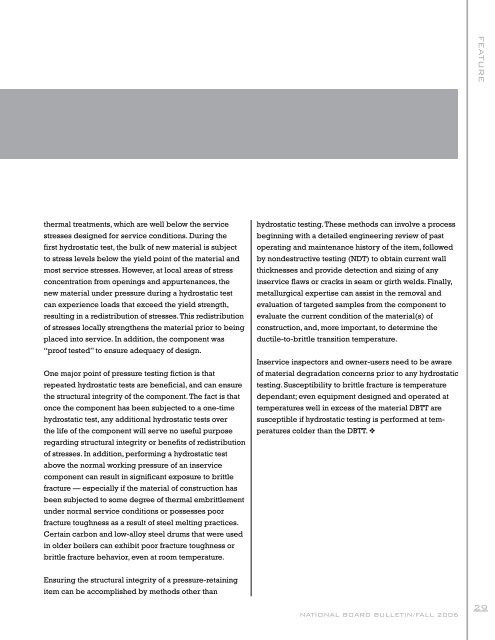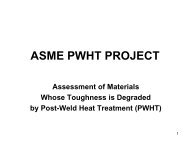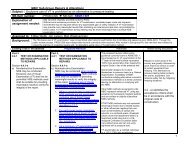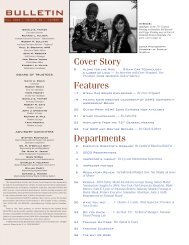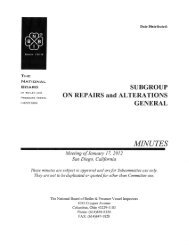bulletin - The National Board of Boiler and Pressure Vessel Inspectors
bulletin - The National Board of Boiler and Pressure Vessel Inspectors
bulletin - The National Board of Boiler and Pressure Vessel Inspectors
Create successful ePaper yourself
Turn your PDF publications into a flip-book with our unique Google optimized e-Paper software.
thermal treatments, which are well below the service<br />
stresses designed for service conditions. During the<br />
first hydrostatic test, the bulk <strong>of</strong> new material is subject<br />
to stress levels below the yield point <strong>of</strong> the material <strong>and</strong><br />
most service stresses. However, at local areas <strong>of</strong> stress<br />
concentration from openings <strong>and</strong> appurtenances, the<br />
new material under pressure during a hydrostatic test<br />
can experience loads that exceed the yield strength,<br />
resulting in a redistribution <strong>of</strong> stresses.This redistribution<br />
<strong>of</strong> stresses locally strengthens the material prior to being<br />
placed into service. In addition, the component was<br />
“pro<strong>of</strong> tested” to ensure adequacy <strong>of</strong> design.<br />
One major point <strong>of</strong> pressure testing fiction is that<br />
repeated hydrostatic tests are beneficial, <strong>and</strong> can ensure<br />
the structural integrity <strong>of</strong> the component. <strong>The</strong> fact is that<br />
once the component has been subjected to a one-time<br />
hydrostatic test, any additional hydrostatic tests over<br />
the life <strong>of</strong> the component will serve no useful purpose<br />
regarding structural integrity or benefits <strong>of</strong> redistribution<br />
<strong>of</strong> stresses. In addition, performing a hydrostatic test<br />
above the normal working pressure <strong>of</strong> an inservice<br />
component can result in significant exposure to brittle<br />
fracture — especially if the material <strong>of</strong> construction has<br />
been subjected to some degree <strong>of</strong> thermal embrittlement<br />
under normal service conditions or possesses poor<br />
fracture toughness as a result <strong>of</strong> steel melting practices.<br />
Certain carbon <strong>and</strong> low-alloy steel drums that were used<br />
in older boilers can exhibit poor fracture toughness or<br />
brittle fracture behavior, even at room temperature.<br />
Ensuring the structural integrity <strong>of</strong> a pressure-retaining<br />
item can be accomplished by methods other than<br />
hydrostatic testing. <strong>The</strong>se methods can involve a process<br />
beginning with a detailed engineering review <strong>of</strong> past<br />
operating <strong>and</strong> maintenance history <strong>of</strong> the item, followed<br />
by nondestructive testing (NDT) to obtain current wall<br />
thicknesses <strong>and</strong> provide detection <strong>and</strong> sizing <strong>of</strong> any<br />
inservice flaws or cracks in seam or girth welds. Finally,<br />
metallurgical expertise can assist in the removal <strong>and</strong><br />
evaluation <strong>of</strong> targeted samples from the component to<br />
evaluate the current condition <strong>of</strong> the material(s) <strong>of</strong><br />
construction, <strong>and</strong>, more important, to determine the<br />
ductile-to-brittle transition temperature.<br />
Inservice inspectors <strong>and</strong> owner-users need to be aware<br />
<strong>of</strong> material degradation concerns prior to any hydrostatic<br />
testing. Susceptibility to brittle fracture is temperature<br />
dependant; even equipment designed <strong>and</strong> operated at<br />
temperatures well in excess <strong>of</strong> the material DBTT are<br />
susceptible if hydrostatic testing is performed at temperatures<br />
colder than the DBTT. v<br />
NATIONAl BOARD BUllETIN/FAll 2006<br />
FEATURE<br />
29


